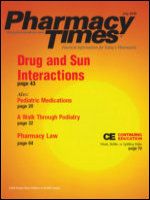Publication
Article
Pharmacy Times
Olmesartan Medoxomil (CS-866) (Benicar)
Author(s):
Hypertension is a serious disease with a significant impact on health and life expectancy. The main goals for the treatment of hypertension are to control blood pressure and prevent complications such as coronary heart disease, renal failure, and cerebral vascular disease. Olmesartan is a new angiotensin receptor antagonist (Benicar, Sankyo Pharma) approved by the FDA for the treatment of hypertension. (1,2)
PharmacologyThe most common antihyperten-sive drugs used for the treatment of hypertension in type 2 diabetes are angiotensin II-receptor antagonists. In contrast to angiotensin-converting enzyme (ACE) inhibitors that down-regulate the production of angiotensin II from angiotensin I, angiotensin II-receptor antagonists bind to angiotensin receptors and block the activity of angiotensin II. According to new guidelines from the American Diabetes Association, angiotensin II-receptor antagonists are the most appropriate and are the drugs of choice for the treatment of hypertension. In patients with persistent microalbuminuria with or without hypertension, the addition of an ACE inhibitor or angiotensin II-receptor antagonist has been recommended.
Olmesartan is a long-acting angio-tensin II-receptor antagonist with excellent antihypertensive activity. Following oral administration, olme-sartan is rapidly absorbed from the gastrointestinal tract and reaches a peak plasma concentration after 1 to 3 hours. Olmesartan is extensively metabolized in the liver, and metabo-lites are excreted in the urine. Approximately 7% to 11% of an oral dose is excreted unchanged in the urine. Therefore, the olmesartan dose should be adjusted in patients with renal dysfunction and the elderly. Recent studies in dogs and rats have demonstrated that olmesartan enhances renal blood flow by selectively reducing renal vascular resistance. In addition to its antihyperten-sive effect, olmesartan exhibits beneficial effects on heart failure and nephrosis and has antiatherogenic effects in hyperlipidemic animals. (3,4)
Clinical StudiesIn an integrated data analysis, 2,540 patients were evaluated. Patients with mild-to-moderate hypertension were randomized to olmesartan. The dosage was titrated to achieve desirable blood pressure control; doses ranged from 10 to 80 mg/day. A mean reduction of diastolic blood pressure of 9.6 to 14 mm Hg was reported. In addition, most patients experienced excellent blood pressure control after 3 weeks of therapy. In a comparative clinical study, after 8 weeks of therapy, significantly lower blood pressure was reported in the olmesartan 20-mg-daily group, compared with losartan 50 mg, valsar-tan 80 mg, and irbesartan 150 mg. (4-6)
Safety
During phase 2 and 3 clinical studies, approximately 2,540 patients were exposed to olmesartan. Olmesartan was well tolerated, and the overall incidence of adverse drug reactions was similar to that of other angiotensin receptor antagonists. The most common drug reactions included headache (5.6%), dizziness (2.8%), and upper respiratory tract infection (3.3%). (5,6)
Outlook
Olmesartan exhibits pharmacody-namic advantages similar to those of other angiotensin II-receptor antagonists. Initial comparative clinical studies indicate that olmesartan is associated with significantly better blood pressure control than other angio-tensin receptor antagonists.
For a list of references, send a stamped, self-addressed envelope to: References Department, Attn. G. Henry, Pharmacy Times, 241 Forsgate Drive, Jamesburg, NJ 08831; or send an e-mail request to: [email protected].

Newsletter
Stay informed on drug updates, treatment guidelines, and pharmacy practice trends—subscribe to Pharmacy Times for weekly clinical insights.






